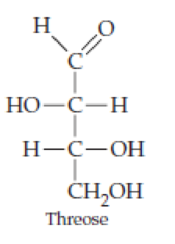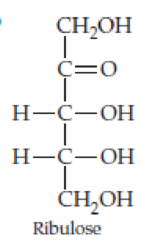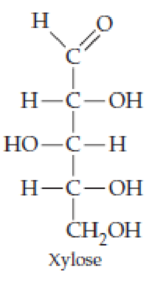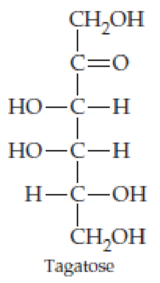
Fundamentals of General, Organic, and Biological Chemistry (8th Edition)
8th Edition
ISBN: 9780134015187
Author: John E. McMurry, David S. Ballantine, Carl A. Hoeger, Virginia E. Peterson
Publisher: PEARSON
expand_more
expand_more
format_list_bulleted
Textbook Question
Chapter 20, Problem 20.31AP
Classify the four carbohydrates (a)–(d) by indicating the nature of the carbonyl group and the number of carbon atoms present. For example, glucose is an aldohexose.




Expert Solution & Answer
Want to see the full answer?
Check out a sample textbook solution
Students have asked these similar questions
H₂N
NH
peptide_0e60
A dipeptide is made up of two (2) amino acids. The figure above shows one such dipeptide with an unknown sequence. Your task is to find out the two (2) letter sequence of this dipeptide.
carbons in each of the structures below. For instance, the central carbon of chloromethylbutane (pictured
3. A chiral carbon is a carbon that is single-bonded to four different types of groups. Identify the chiral
above) is a chiral carbon. (Can you see how the groups attached to it are all chemically different?)
In each of the chiral molecules below, identify all the carbons that are chiral carbons by drawing a circle
around each one of them.
(a) the carbohydrate glucose
H
O
(b) the carbohydrate fructose
CH₂OH
1C
H-C-OH
3
HO-C-H
4
H-C-OH
5
H-C-OH
6CH₂OH
D-Glucose
(linear form)
(c) the amino acid leucine
O
O
H3C.
HO H
H-
-OH
CH 3 NH2
H-
-OH
CH₂OH
OH
We always include controls in the Annexin-V-GFP/Propidium Iodide flow cytometric assay to study apoptosis. List four types of controls in this assay.
Why do we need these controls? Explain your answers.
After the flow assay, if we like to examine the morphology of the viable, early apoptotic and late apoptotic cells by confocal microscopy, what can we do and what are the expected results?
Chapter 20 Solutions
Fundamentals of General, Organic, and Biological Chemistry (8th Edition)
Ch. 20.1 - Classify the following monosaccharides as an...Ch. 20.1 - Prob. 20.2PCh. 20.2 - Prob. 20.3PCh. 20.2 - Prob. 20.4PCh. 20.2 - Prob. 20.6PCh. 20.3 - D-Talose, a constituent of certain antibiotics,...Ch. 20.3 - Prob. 20.8PCh. 20.3 - Draw the structure that completes the mutarotation...Ch. 20.4 - Prob. 20.10KCPCh. 20.4 - Prob. 20.11P
Ch. 20.4 - Prob. 20.12PCh. 20.4 - Prob. 20.13PCh. 20.4 - Prob. 20.1CIAPCh. 20.4 - Prob. 20.2CIAPCh. 20.4 - All cells in your body contain glycoproteins...Ch. 20.5 - Draw the structure of the and anomers that...Ch. 20.6 - Prob. 20.15PCh. 20.6 - Prob. 20.16PCh. 20.6 - Prob. 20.17KCPCh. 20.7 - Prob. 20.4CIAPCh. 20.7 - Prob. 20.5CIAPCh. 20.7 - Prob. 20.6CIAPCh. 20.7 - Prob. 20.7CIAPCh. 20.7 - Prob. 20.18PCh. 20.7 - Prob. 20.19PCh. 20.7 - Prob. 20.8CIAPCh. 20.7 - Prob. 20.9CIAPCh. 20.7 - Prob. 20.10CIAPCh. 20 - During the digestion of starch from potatoes, the...Ch. 20 - Prob. 20.21UKCCh. 20 - Consider the trisaccharide A, B, C shown in...Ch. 20 - Hydrolysis of both glycosidic bonds in the...Ch. 20 - Prob. 20.24UKCCh. 20 - Are one or more of the disaccharides maltose,...Ch. 20 - Prob. 20.26UKCCh. 20 - Prob. 20.27UKCCh. 20 - Prob. 20.28APCh. 20 - What is the family-name ending for a sugar?Ch. 20 - Prob. 20.30APCh. 20 - Classify the four carbohydrates (a)(d) by...Ch. 20 - Prob. 20.32APCh. 20 - How many chiral carbon atoms are there in each of...Ch. 20 - Prob. 20.34APCh. 20 - Prob. 20.35APCh. 20 - Name four important monosaccharides and tell where...Ch. 20 - Prob. 20.37APCh. 20 - Prob. 20.38APCh. 20 - What is the structural relationship between...Ch. 20 - Prob. 20.40APCh. 20 - In Section 15.6, you saw that aldehydes react with...Ch. 20 - Sucrose and D-glucose rotate plane-polarized light...Ch. 20 - Prob. 20.43APCh. 20 - Prob. 20.44APCh. 20 - Prob. 20.45APCh. 20 - What is mutarotation? Do all chiral molecules do...Ch. 20 - What are anomers, and how do the anomers of a...Ch. 20 - What is the structural difference between the ...Ch. 20 - D-Gulose, an aldohexose isomer of glucose, has the...Ch. 20 - Prob. 20.50APCh. 20 - In its open-chain form, D-altrose has the...Ch. 20 - Prob. 20.52APCh. 20 - Prob. 20.53APCh. 20 - Prob. 20.54APCh. 20 - Prob. 20.55APCh. 20 - What is the structural difference between a...Ch. 20 - What are glycosides, and how can they be formed?Ch. 20 - Prob. 20.58APCh. 20 - Prob. 20.59APCh. 20 - Give the names of three important disaccharides....Ch. 20 - Lactose and maltose are reducing disaccharides,...Ch. 20 - Amylose (a form of starch) and cellulose are both...Ch. 20 - Prob. 20.63APCh. 20 - Prob. 20.64APCh. 20 - Prob. 20.65APCh. 20 - Gentiobiose, a rare disaccharide found in saffron,...Ch. 20 - Prob. 20.67APCh. 20 - Prob. 20.68APCh. 20 - Prob. 20.69APCh. 20 - Amylopectin (a form of starch) and glycogen are...Ch. 20 - What is the physiological purpose of starch in a...Ch. 20 - Prob. 20.72APCh. 20 - Prob. 20.73APCh. 20 - Prob. 20.74CPCh. 20 - Prob. 20.75CPCh. 20 - Prob. 20.76CPCh. 20 - Prob. 20.77CPCh. 20 - Prob. 20.78CPCh. 20 - Write the open-chain structure of the only...Ch. 20 - Prob. 20.80CPCh. 20 - Prob. 20.81CPCh. 20 - When a person cannot digest galactose, its reduced...Ch. 20 - Describe the differences between mono-, di-, and...Ch. 20 - Prob. 20.84CPCh. 20 - Prob. 20.85CPCh. 20 - Many people who are lactose intolerant can eat...Ch. 20 - Prob. 20.87GPCh. 20 - Prob. 20.88GPCh. 20 - Prob. 20.89GP
Knowledge Booster
Learn more about
Need a deep-dive on the concept behind this application? Look no further. Learn more about this topic, biochemistry and related others by exploring similar questions and additional content below.Similar questions
- 3. (2 points) Your lab partner accidentally used a pen instead of a pencil to mark the baseline and label the lanes of their TLC plate. Briefly (1-2 sentences for each point) describe (a) what would happen to the ink when you develop the TLC plate; and (b) how this would affect the experiment. 1arrow_forwardCan you help me with question 4arrow_forwardDetermine Km and Vmax from the michaelis menten grapharrow_forward
- Determine the Km and Vmax from the lineweuver burk grapharrow_forwardDo schwann cells produce or act as myelin in the peripheral nervous system? I know that they encase and wrap around axons, but where does the myelin come into play?arrow_forwardThe enzyme lactate dehydrogenase (LDH) catalyzes the conversion of pyruvate to lactatein skeletal muscle cells using NAD/NADH during anaerobic “balanced” fermentation.Answer the following questions about this reaction. (a) Write out the two reductive half reactions and indicate the E ̊' for each half reaction. Write out the full balanced reaction for the pyruvate to lactate rxn and indicate the ∆E ̊' for the reaction. (b) What is the free energy change under standard state conditions for thisreaction? Which direction is spontaneous?(c) Assume that in skeletal muscle cells the ratio of [NAD+] to [NADH] is 100, and that the[pyruvate] = 0.40 mM and [lactate] = 4.0 mM. What is the free energy change (∆G')for the conversion of pyruvate to lactate? Indicate the direction in which the reactionis spontaneous under these cellular conditions.arrow_forward
- Why did the authors worry about the temperature-dependent solubility of the carriers in thebilayer? How did the authors determine whether the effect of freezing the lipid bilayer wasto decrease the solubility of the carriers (nonactin and valinomycin) or whether the effectwas to impair their ability to diffuse through the membrane (decrease their mobility)?arrow_forwardKranse et. al. measured the temperature dependence of conductance using membranescontaining the phospholipids glyceryl dipalmitate and glyceryl distearate. Describe themodifications in membrane content that you would employ to: (a) shift the temperature of the phase transition (b) make the ion conductance curve for valinomycin andnonactin more like that of gramicidinarrow_forwardObtain the sequence for the 5-HT receptor HTR1A and generate a hydropathy plot usingthe ExPASY tool ProtScale, the appropriate window, and the Kyte-Doolittle weightingalgorithm. How many transmembrane domains are present in this receptor? Attach yourhydropathy plot to your assignment.arrow_forward
- Compare and contrast the structural features of the ion carrier valinomycin with those of achannel former like gramicidin. How does structural information help explain the mechanismby which these molecules conduct ions across membranes?arrow_forwardA typical integral membrane protein has a stretch (or stretches) of ~20 hydrophobic aminoacids that form an α-helix that spans the bilayer (as is found in membrane proteins such asglycophorin A and bacteriorhodopsin). Compare and contrast the molecular and structural features of gramicidin with a membrane-spanning α-helix. Explain how gramicidin can forman ion channel when a typical membrane-spanning α-helix cannot (eg, glycophorin A).arrow_forwardThe titration curve of alanine shows the ionization of two functional groups with pK values of 2.34 and 9.69, corresponding to the ionization of the carboxyl and the protonated amino groups, respectively. The titration of di-, tri-, and larger oligopeptides of alanine also shows the ionization of only two functional groups, although the experimental pK values are different. The table summarizes the trend in pK values. Amino acid or peptide Ala Ala-Ala pKj pk₂ 2.34 9.69 3.12 8.30 Ala-Ala-Ala 3.39 8.03 Ala-(Ala)-Ala, n ≥ 4 3.42 7.94 Modify the molecules to show the oligopeptide Ala-Ala-Ala. You can modify the molecules by moving, adding, deleting, or changing atoms, bonds, or charges. C Select c Draw Templates More H с N 0 S Cl H H | | || H CH3 H CH, H CH₂ Complete the statements about the the pK, values of the Ala-Ala-Ala oligopeptide. The pK₁ value of 3.39 is associated with the -COO group of Ala-Ala-Ala. The pK2 value of 8.03 is associated with the -NH group of Ala-Ala-Ala. Erase Q2 Q…arrow_forward
arrow_back_ios
SEE MORE QUESTIONS
arrow_forward_ios
Recommended textbooks for you
 Biology Today and Tomorrow without Physiology (Mi...BiologyISBN:9781305117396Author:Cecie Starr, Christine Evers, Lisa StarrPublisher:Cengage Learning
Biology Today and Tomorrow without Physiology (Mi...BiologyISBN:9781305117396Author:Cecie Starr, Christine Evers, Lisa StarrPublisher:Cengage Learning
 Anatomy & PhysiologyBiologyISBN:9781938168130Author:Kelly A. Young, James A. Wise, Peter DeSaix, Dean H. Kruse, Brandon Poe, Eddie Johnson, Jody E. Johnson, Oksana Korol, J. Gordon Betts, Mark WomblePublisher:OpenStax College
Anatomy & PhysiologyBiologyISBN:9781938168130Author:Kelly A. Young, James A. Wise, Peter DeSaix, Dean H. Kruse, Brandon Poe, Eddie Johnson, Jody E. Johnson, Oksana Korol, J. Gordon Betts, Mark WomblePublisher:OpenStax College Biology (MindTap Course List)BiologyISBN:9781337392938Author:Eldra Solomon, Charles Martin, Diana W. Martin, Linda R. BergPublisher:Cengage Learning
Biology (MindTap Course List)BiologyISBN:9781337392938Author:Eldra Solomon, Charles Martin, Diana W. Martin, Linda R. BergPublisher:Cengage Learning Biology 2eBiologyISBN:9781947172517Author:Matthew Douglas, Jung Choi, Mary Ann ClarkPublisher:OpenStax
Biology 2eBiologyISBN:9781947172517Author:Matthew Douglas, Jung Choi, Mary Ann ClarkPublisher:OpenStax

Biology Today and Tomorrow without Physiology (Mi...
Biology
ISBN:9781305117396
Author:Cecie Starr, Christine Evers, Lisa Starr
Publisher:Cengage Learning


Anatomy & Physiology
Biology
ISBN:9781938168130
Author:Kelly A. Young, James A. Wise, Peter DeSaix, Dean H. Kruse, Brandon Poe, Eddie Johnson, Jody E. Johnson, Oksana Korol, J. Gordon Betts, Mark Womble
Publisher:OpenStax College

Biology (MindTap Course List)
Biology
ISBN:9781337392938
Author:Eldra Solomon, Charles Martin, Diana W. Martin, Linda R. Berg
Publisher:Cengage Learning

Biology 2e
Biology
ISBN:9781947172517
Author:Matthew Douglas, Jung Choi, Mary Ann Clark
Publisher:OpenStax

GCSE Chemistry - Acids and Bases #34; Author: Cognito;https://www.youtube.com/watch?v=vt8fB3MFzLk;License: Standard youtube license